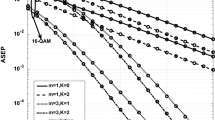Abstract
The orthogonal frequency division multiplexing (OFDM) transmission scheme is currently experiencing increased popularity due to advances in very large scale integration technology. It is used for a variety of broadband systems such as asymmetric digital subscriber lines, very-high-speed digital subscriber lines, digital video, and audio broadcasting, and wide local area network standards such as IEEE 802.11a, IEEE 802.11 g, and ETSI Hiperlan/2. However, propagation impairments can cause severe degradation in bit error rates (BER) for coherent detection. We derive a semi-analytical method to evaluate BER of a quadrature phase shift keying (QPSK)-OFDM system in Nakagami, m < 1 fading and additive noise where pilot-assisted linear channel estimation and channel equalization are used. This allows modeling of more severe fading environments than can be depicted by a Rayleigh distribution. Numerical simulations are used to validate the proposed methods. The techniques developed can be applied to other channel estimation techniques, modulation schemes and the performance evaluation of equalized single carrier narrowband systems.
Similar content being viewed by others
References
Cimini L.J. Jr., July (1985) “Analysis and Simulation of a Digital Mobile Channel Using Orthogonal Frequency Division Multiplexing”. IEEE Transactions Communication, 33(7): 665–675
W. Zhang, X.G. Xia, P.C. Ching, and W.K. Ma, “On the Number of Pilots for OFDM System in Multi-path Fading Channels”, in Proc. IEEE International Conference on Acoustics, Speech, and Signal Processing, Vol. 4, pp. 381–384, May 2004.
Stuber G.L. (2001) Principles of Mobile Communications, 2nd edn. Boston, Kluwer Academic Publishers
Chang M.X., Su Y.T. Oct. (2002).“Performance Analysis of Equalized OFDM Systems in Rayleigh Fading”. IEEE Transactions Wireless Communication, 1(4): 721–732
Nakagami M. (1960).“The m-distribution-a General Formula of Intensity of Rapid Fading,”. In: Hoffman W.C.(eds). Statistical Methods of Radio Wave Propagation. Oxford, UK Pergamon, pp. 3–36
P.A. Count, Performance Analysis of OFDM in Frequency-Selective, Slowly Fading Nakagami Channels, Master’s Thesis, Naval Postgraduate School: Monterey, CA, USA, 2001.
Du Z., Cheng J., Beaulieu N.C. Feb (2006) “Accurate Error-rate Performance of OFDM on Frequency-Selective Nakagami-m Fading Channels”. IEEE Transactions Communication, 54(2): 319–328
Wang L.C., Lin Y.W., Liu W.C. “Cross-layer Goodput Analysis for Rate Adaptive IEEE 802.11a WLAN in the Generalized Nakagami Fading Channel”. Proceedings IEEE International Conference Communication, 2312–2316, June 2004.
Rohling H., May T., Bruninghaus K., Grunheid R . Oct (1999) “Broad-band OFDM Radio Transmission for Multimedia Applications”. Proceedings IEEE, 87(10): 1778–1789
V. Subotic and S. Primak, “A New Vector Channel Simulator for Sub-Rayleigh Fading”, Proceedings ECWT ‘04, pp. 49–52, Oct. 2004.
Abramowitz M., Stegun I.A.(eds.) (1970). Handbook of Mathematical Functions. New York, Dover Publications Inc.
V. Subotic, Error Performance Evaluation of Wireless Communication Systems in the Presence of Non-Rayleigh Channel Fading, Doctoral Thesis, The University of Western Ontario: London, N, Canada, 2005.
S. Primak, V. Lyandres, and V. Kontorovich, “Markov Models of Non-Gaussian Exponentially Correlated Processes and Their Applications”, Physics Review E, Vol. 63, No. 6, June 2001.
J.G. Proakis and M. Salehi, Contemporary Communication Systems Using MATLAB, Pacific Grove, CA, Brooks/Cole: 2000.
Clarke R.H. July/Aug. (1968). “A Statistical Theory of Mobile Radio Reception”. Bell System Technical Journal, 47(6): 957–1000
Author information
Authors and Affiliations
Corresponding author
Rights and permissions
About this article
Cite this article
Subotic, V., Primak, S. BER Analysis of Equalized OFDM Systems in Nakagami, m < 1 Fading. Wireless Pers Commun 40, 281–290 (2007). https://doi.org/10.1007/s11277-006-9190-y
Published:
Issue Date:
DOI: https://doi.org/10.1007/s11277-006-9190-y




